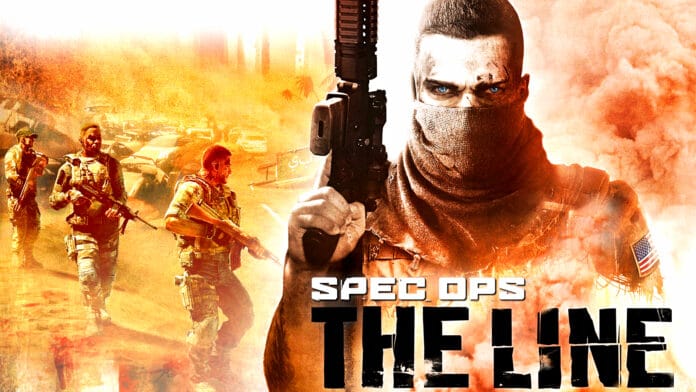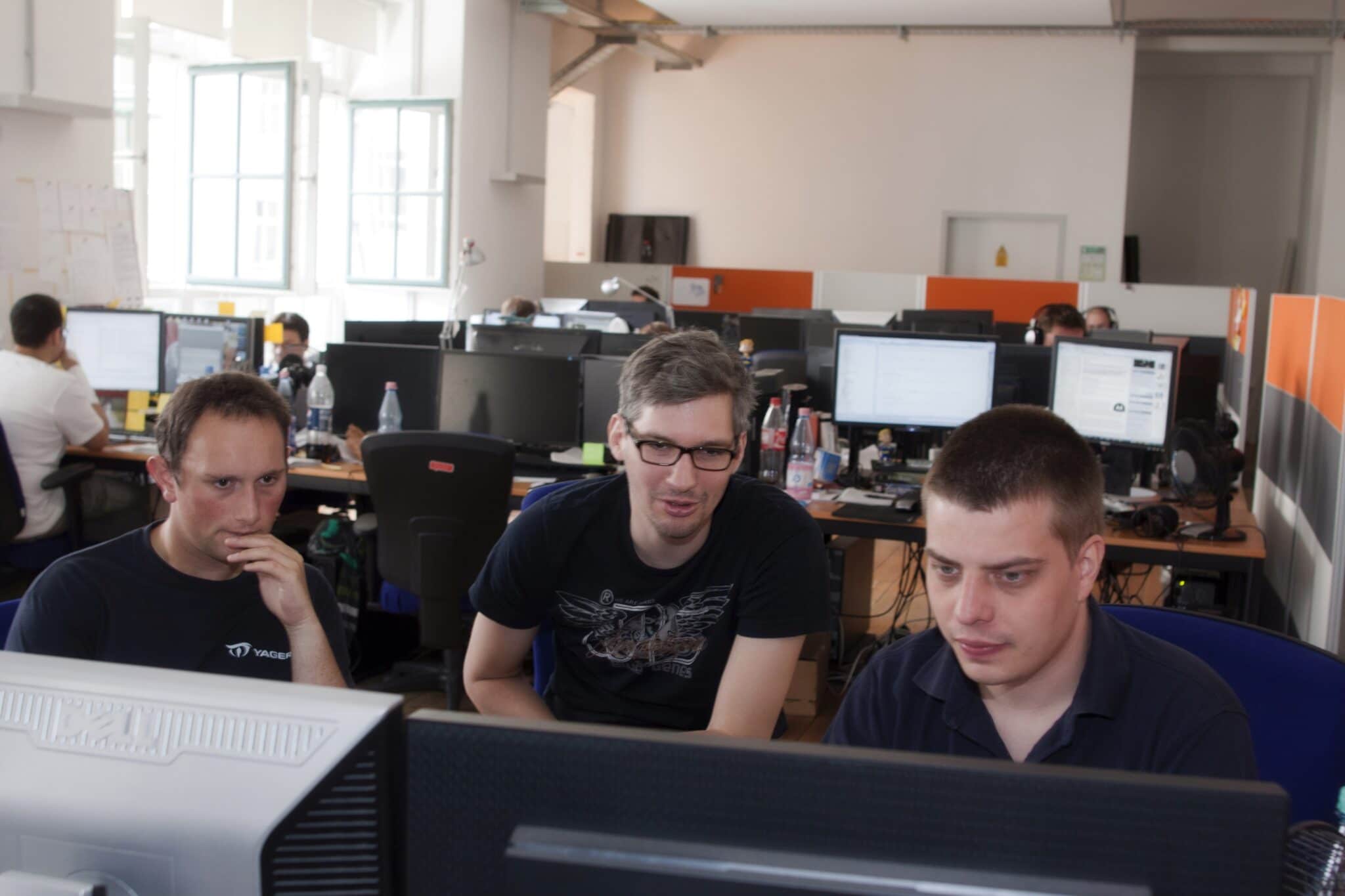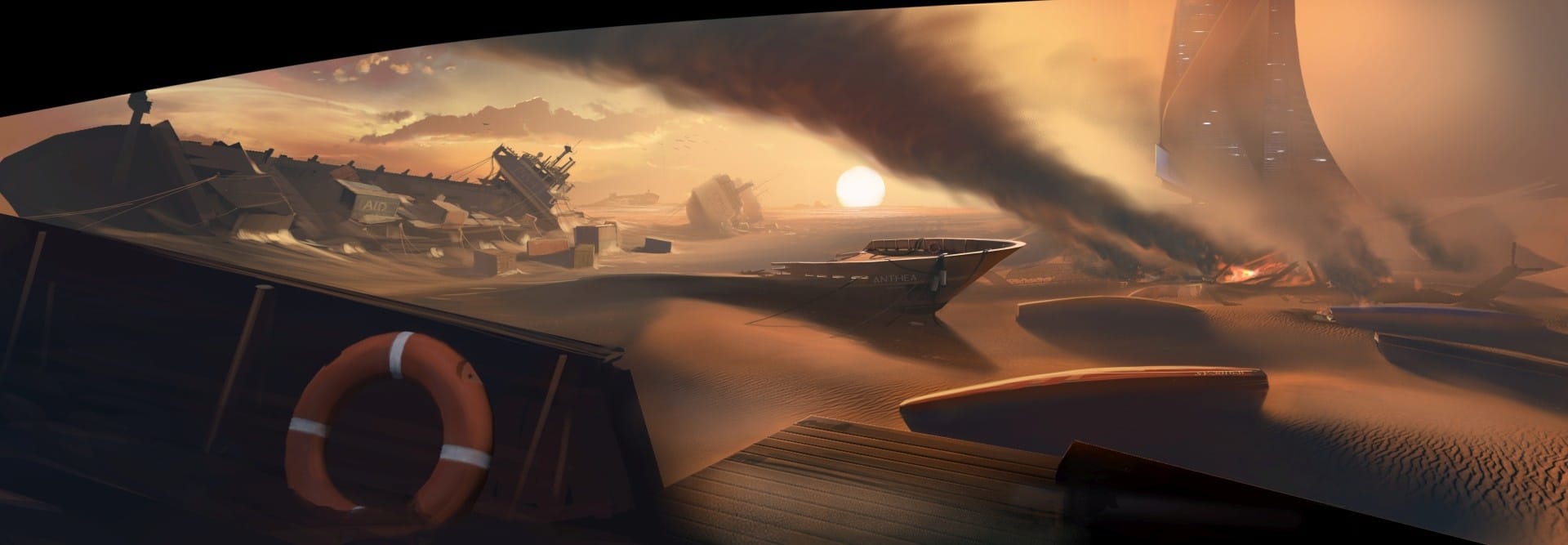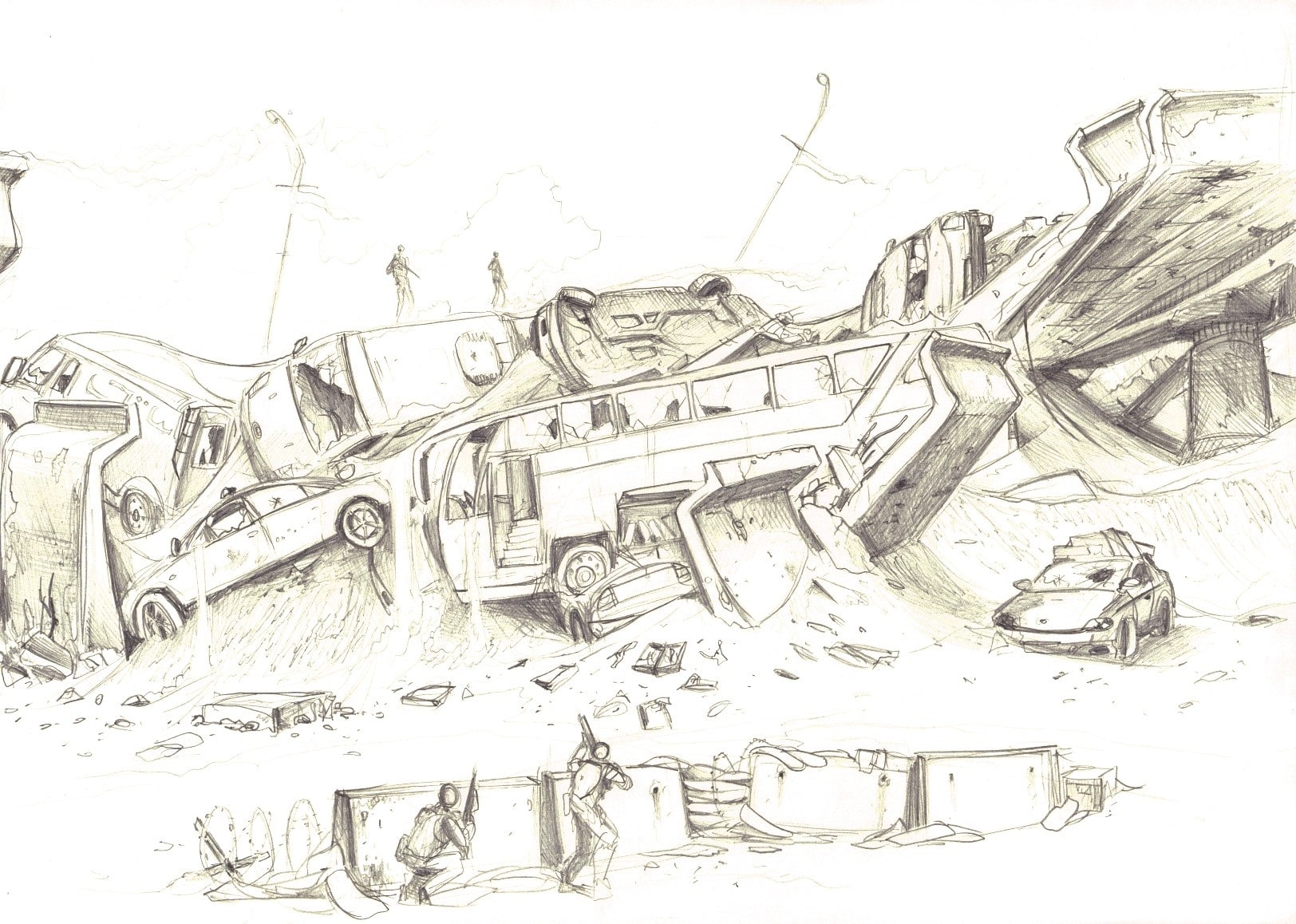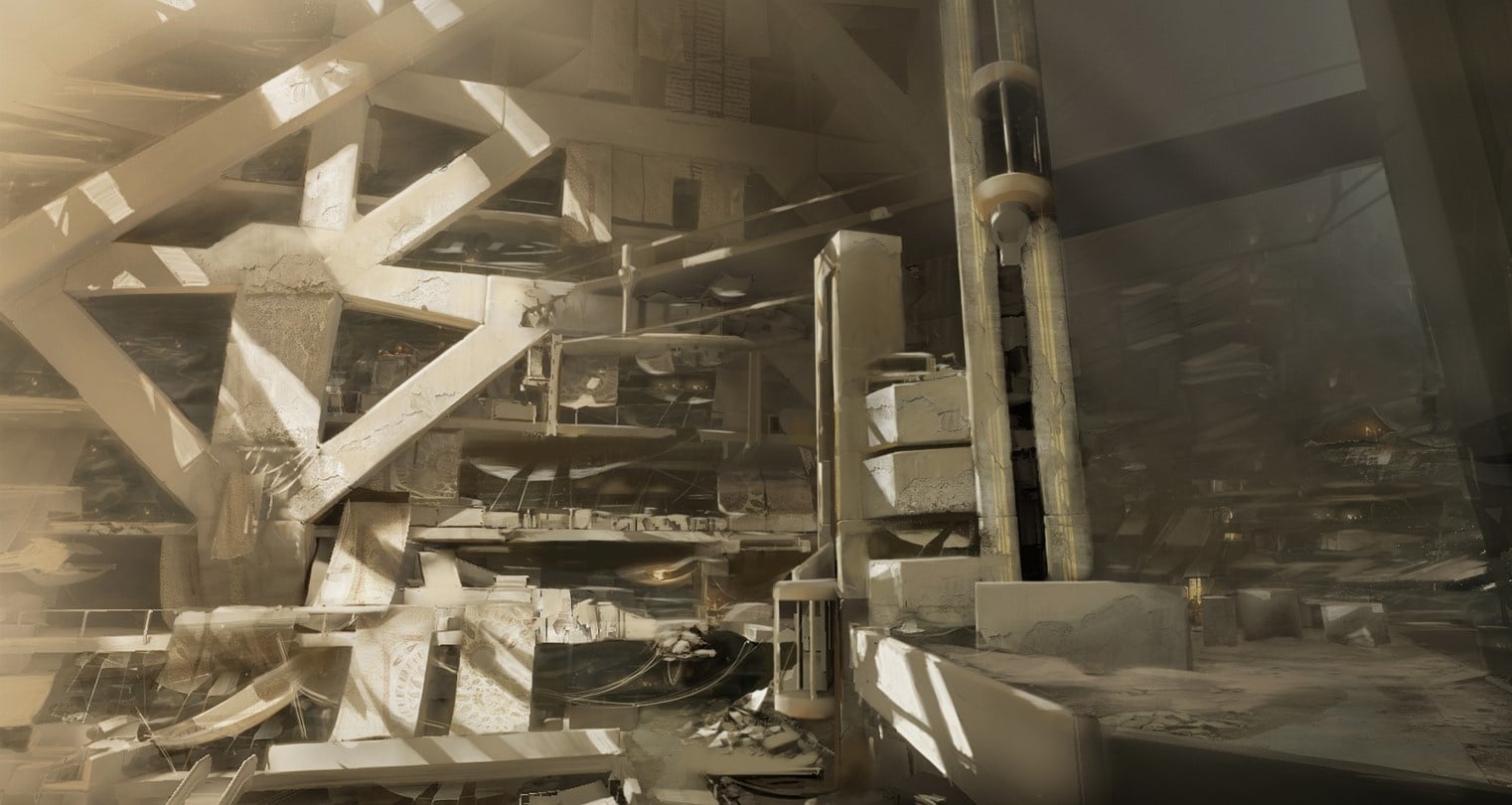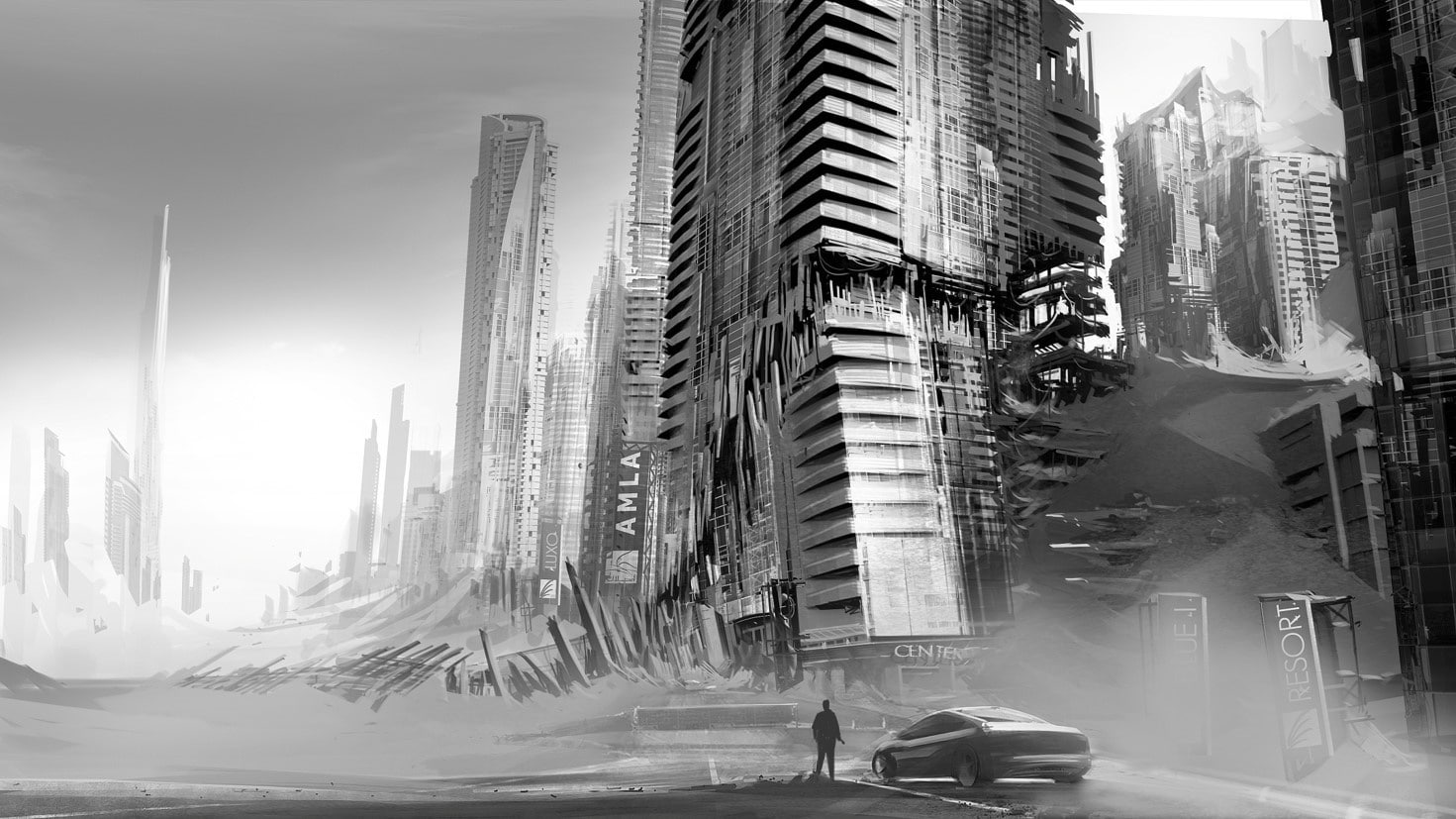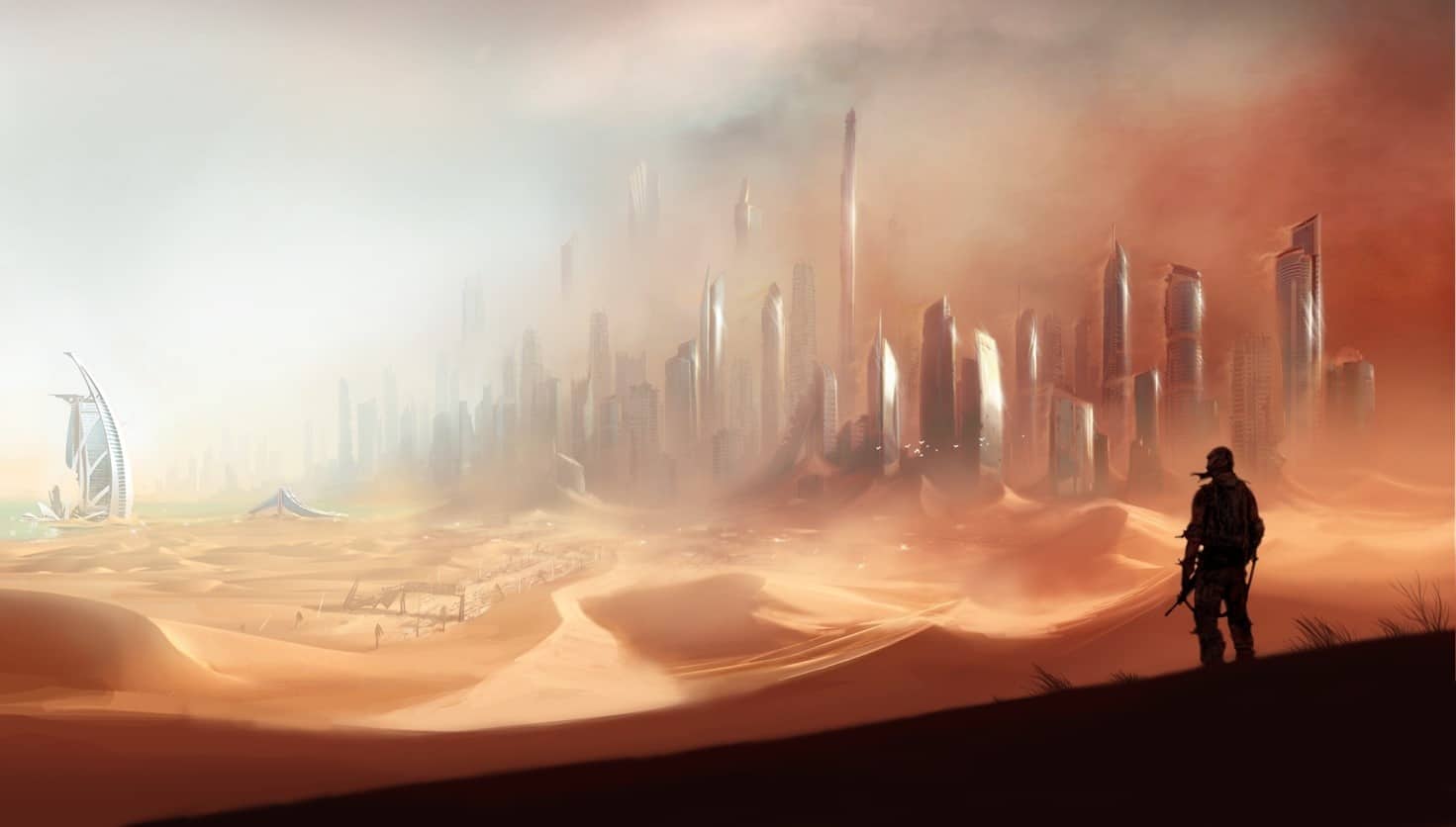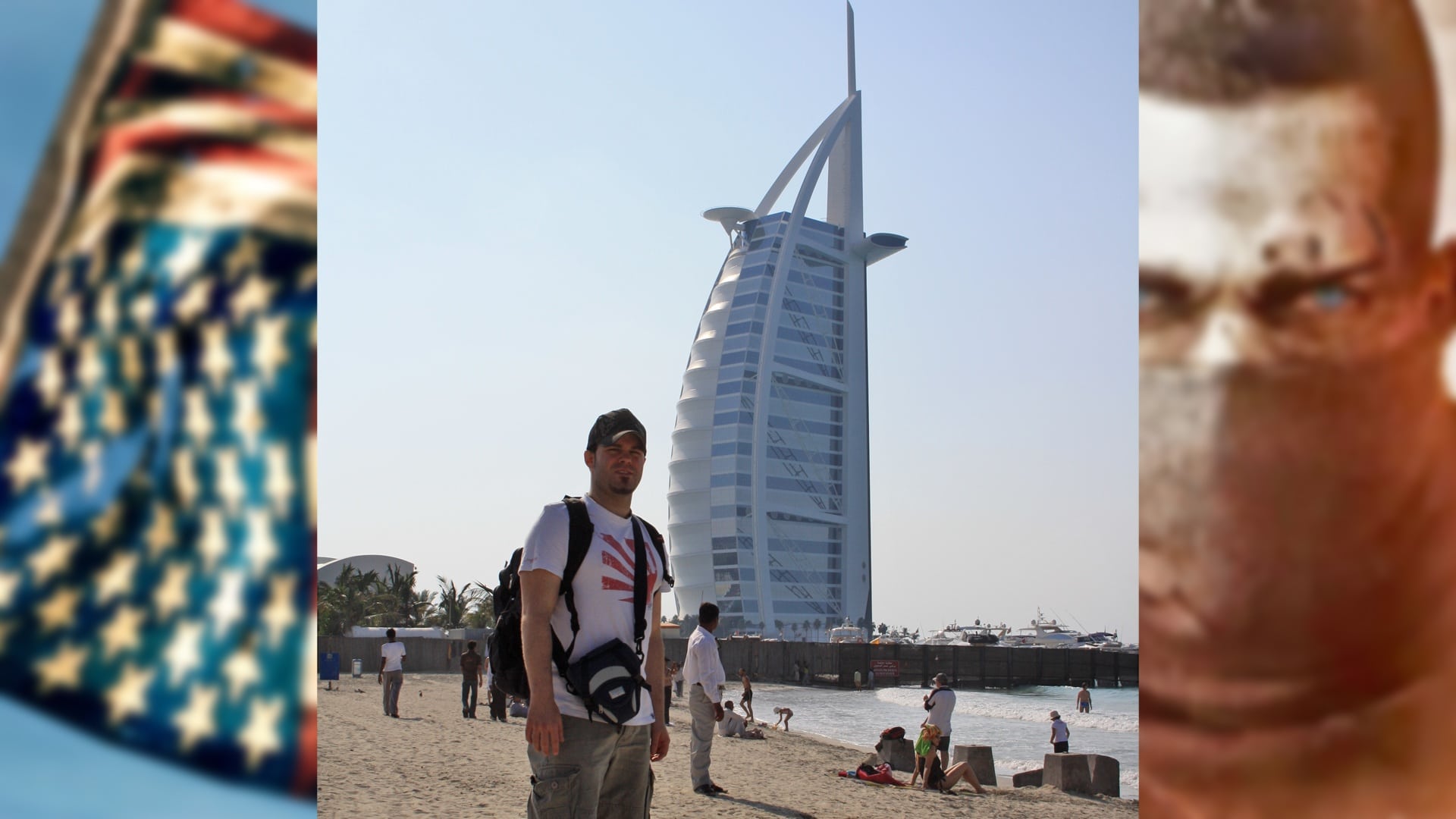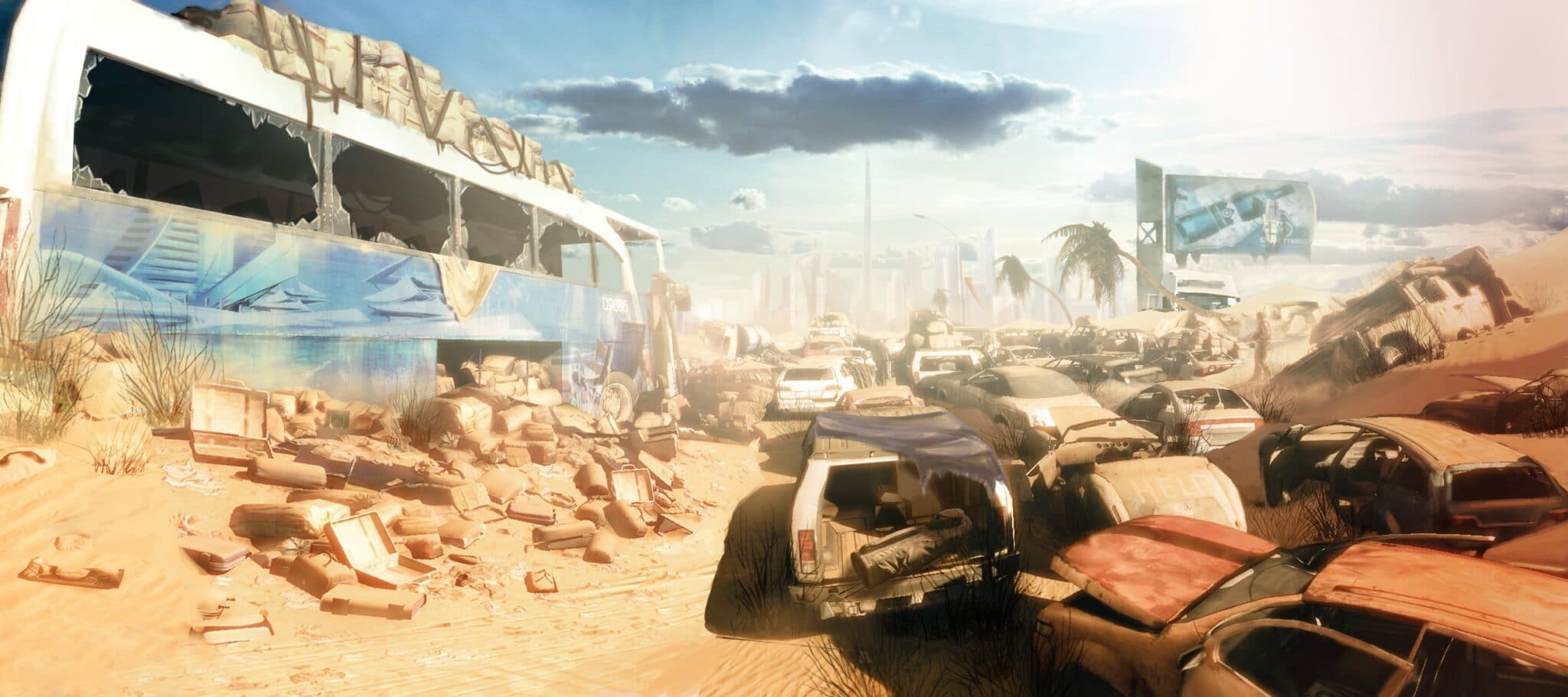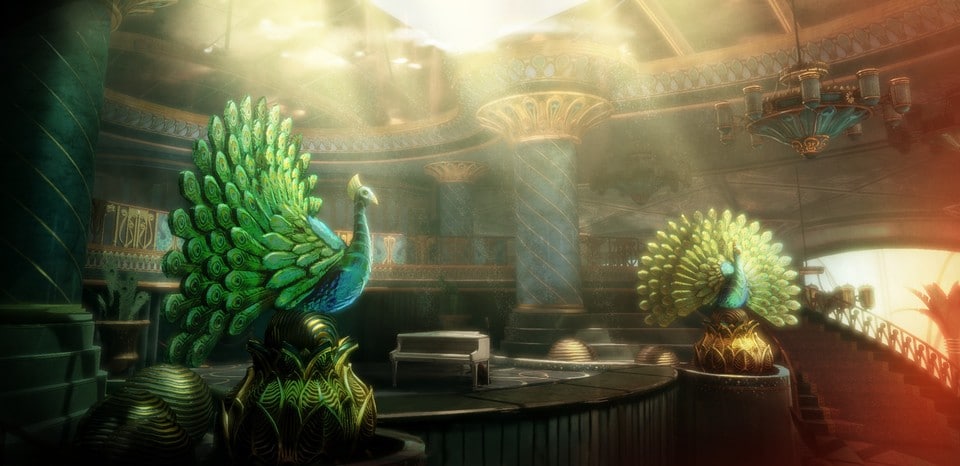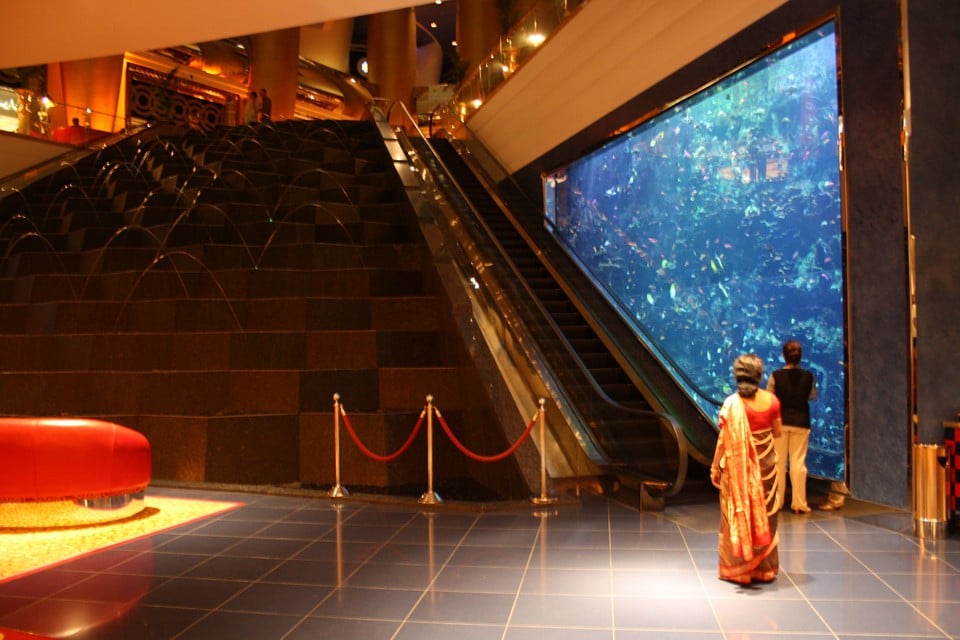Yager’s anti-war shooter is ten years old this year. GlobalESportNews spoke to its developers and traces the creation process. A story about sand, morality and violence.
Buried under piles of drawings and sketches is the blue Tupperware box. Its bottom is covered with reddish desert sand. In 2008, Yager’s art director Matthias Wiese secretly scooped it out of the dunes around Dubai as he gathered impressions for a new shooter. A shooter that cost the Yager development team nerves and sold poorly. But also a shooter that held a mirror up to the genre and revolutionised it with its story.
GlobalESportNews was able to talk to six developers who embarked on the journey into the heart of darkness in 2006 and still remember the turbulent times ten years after its release in 2012. This is the story of Spec Ops: The Line.
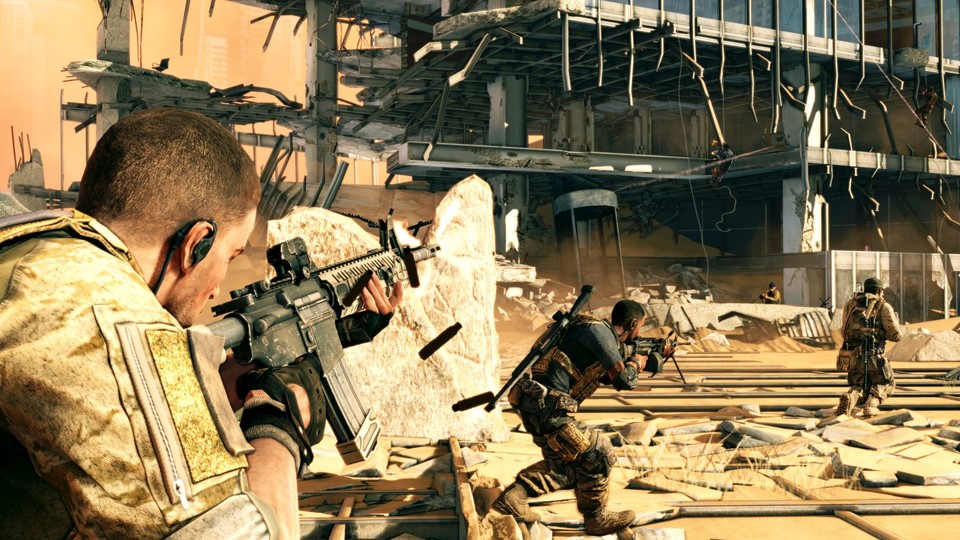
Table of Contents
From Berlin to Dubai
It’s 2005, the iPhone doesn’t yet exist, Grand Theft Auto: San Andreas is conquering the sales charts and Duke Nukem Forever is already a running gag. The small Berlin studio Yager has not released a new game in two years. There are no new commissions in sight and money is starting to run out.
“That was a difficult time for us back then, we needed a deal as quickly as possible,” Timo Ullmann recalls. In 1999, he and friends founded Yager, with roots in the former GDR in East Berlin. In 2005, the team consists of about a dozen employees and tinkers with various ideas, including an action adventure in the Star Wars universe similar to Star Wars: Battlefront. But LucasArts is not interested and blocks the project. Time is running out.
A gameplay prototype called Stealth Ranger is supposed to turn the tide. Yager spent several months working on the sci-fi shooter, in which the player commands a squad through a devastated Dubai. “In 2006 we presented the prototype to 2K and they were immediately interested,” says Ullmann.
The Americans are particularly fascinated by the Dubai scenario. The metropolis in the United Arab Emirates was largely unknown to many in the USA at the time. The former fishing village has skyrocketed due to the oil boom and is dripping with decadence and megalomania. Aquariums, ski slopes and malls stand in the middle of the desert. The world’s tallest building, the Burj Khalifa, towers in the centre of the city. It is the perfect setting for a shooter.
Caution, light spoilers
This article talks in detail about a specific (and very famous) scene from the plot of Spec Ops: The Line. The relevant part has been marked with a spoiler warning, you can skip it if you want. In addition, the general themes and motives of the story are unravelled in more detail, each without its own warning. The end of the story is not part of this article.
2K offers Yager to further develop the prototype based on the Spec Ops licence. Spec Ops: Rangers Lead the Way kicked off the series of military simulations for the PC in 1998. Take-Two Interactive bought the brand in the early 2000s, a reboot by former studio Rockstar Vancouver failed. Now they want to make a new attempt with Yager.
In 2006, the studio signed a contract with 2K. At this time, the publisher has several shooters in development that are supposed to revolutionise the genre. 2006 sees the release of Prey with a Native-American as the protagonist. Bioshock follows in 2007, which is set in the underwater city of Rapture and remains a milestone to this day. 2K is prepared to invest a lot of money in ideas that stand out from the shooter monotony.
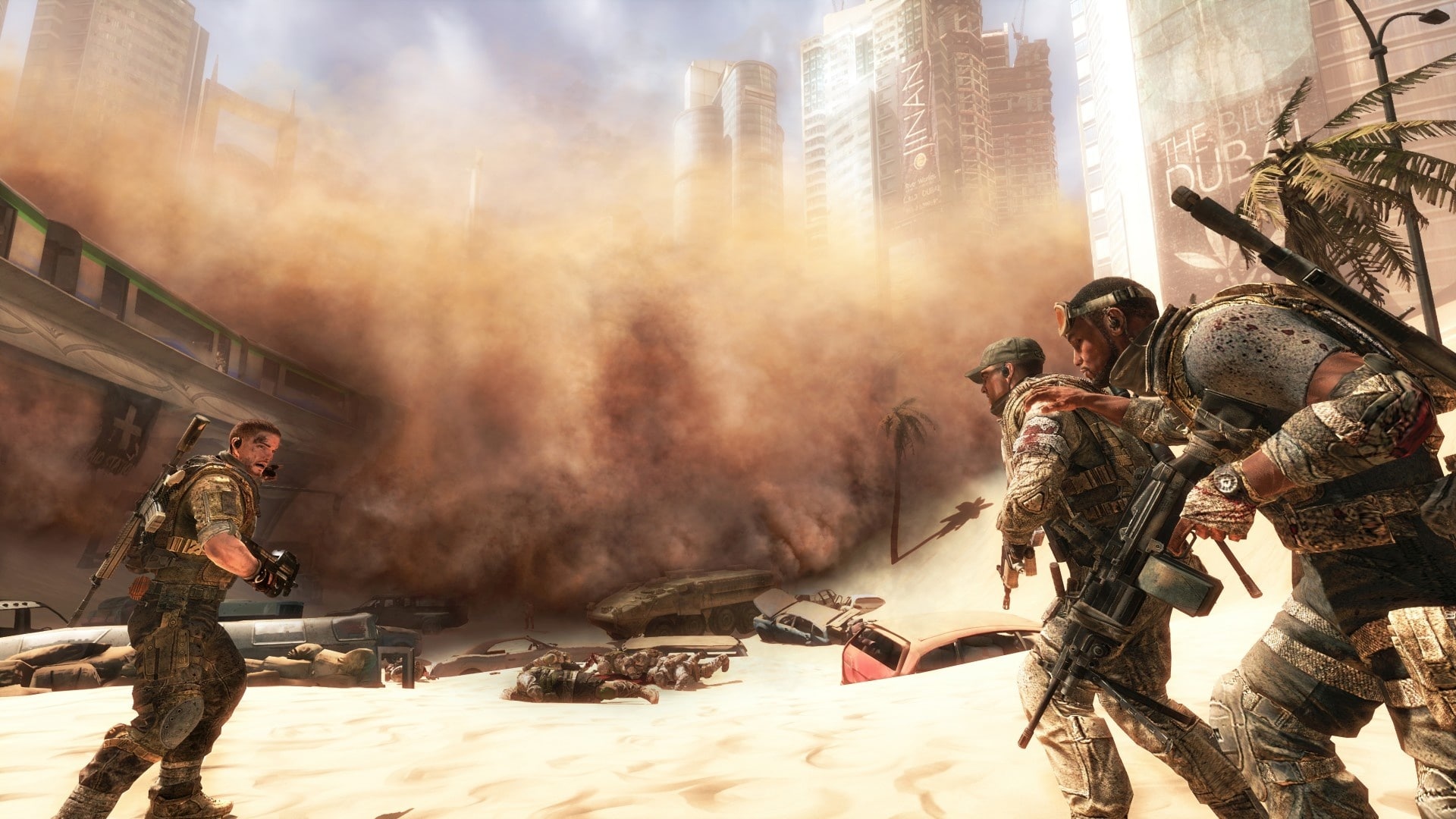
Stealth Ranger, the sci-fi shooter
Over the next few months, Yager continues to develop the sci-fi prototype with an emphasis on stealth. Camouflage suits, similar to those in Crysis, are intended to make the player invisible, and it will also be possible to climb walls. There are also plans for larger outdoor levels with vehicles and airships.There is little sign of the later Spec Ops: The Line in the blueprint at the beginning of 2007, apart from the Dubai idea.
“The gameplay worked well and was fun, but it was still generic, had no common thread and there was no story yet either,” says Ullmann. 2K suggests the new spec ops shooter will have a strong storyline.
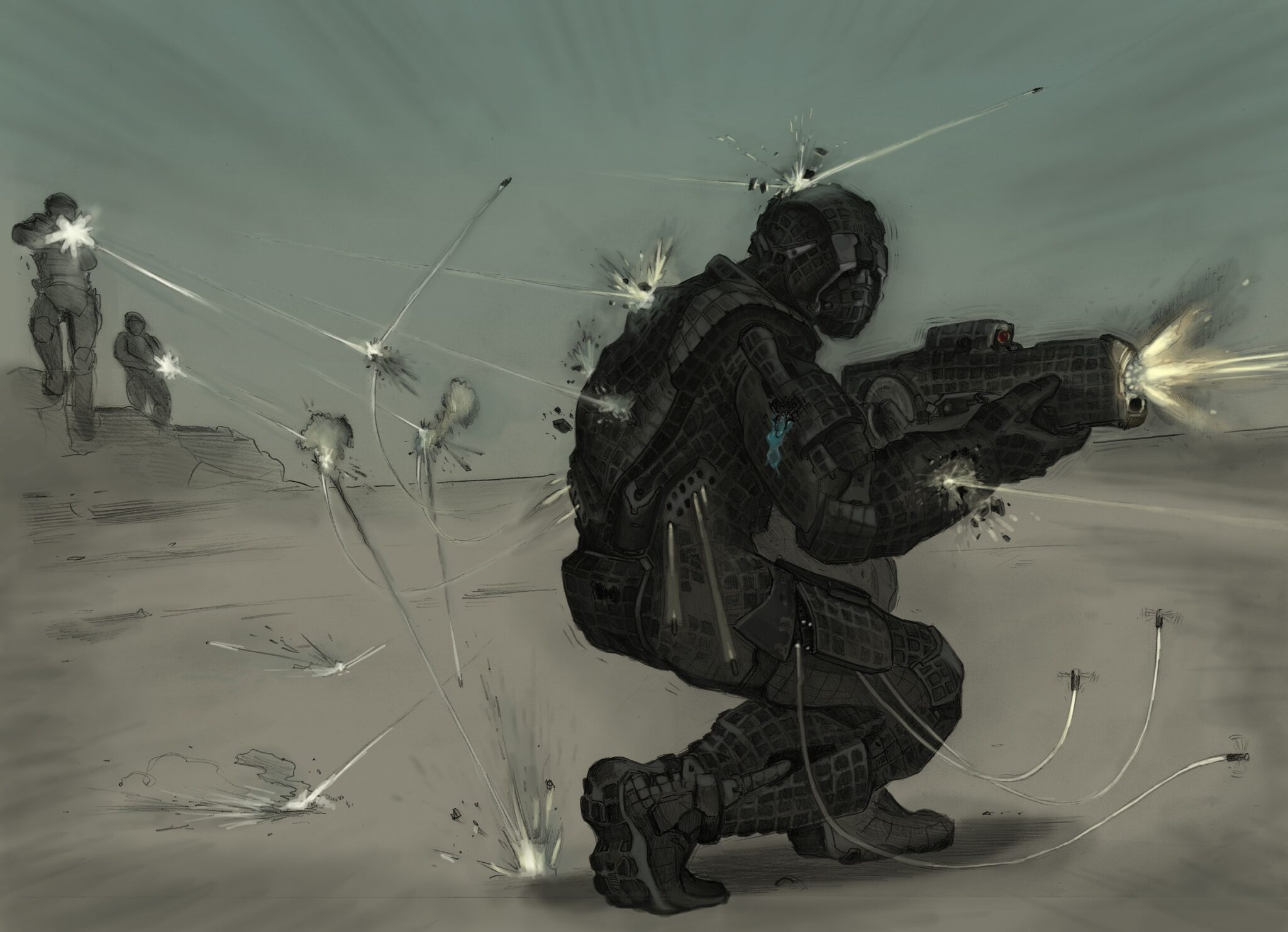
For a AAA game, the Yager team, still small in 2007, needs many new employees. Within a few years, almost 100 people work at the Berlin studio, and the internal team language changes from German to English.
Yager moves to its current office on the Spree in Kreuzberg, right on the former inner-German border. From the meeting room, you can see the East Side Gallery, a preserved piece of the Berlin Wall that doubles as an open-air gallery.
To help the studio with the story, 2K is bringing in its own writers, including Walt Williams, who is working on the game as lead writer. “Setting the story in Dubai was very exciting, plus it allowed us to show a side of the Middle East that is rare in the military shooter genre,” says Williams. The US-American grew up in Louisina, commutes between the US and Berlin during development and lives in a flat in Berlin-Friedrichshain for a few months. He reveals more in his book “Significant Zero” (see box).
Reading tip: Signifiant Zero
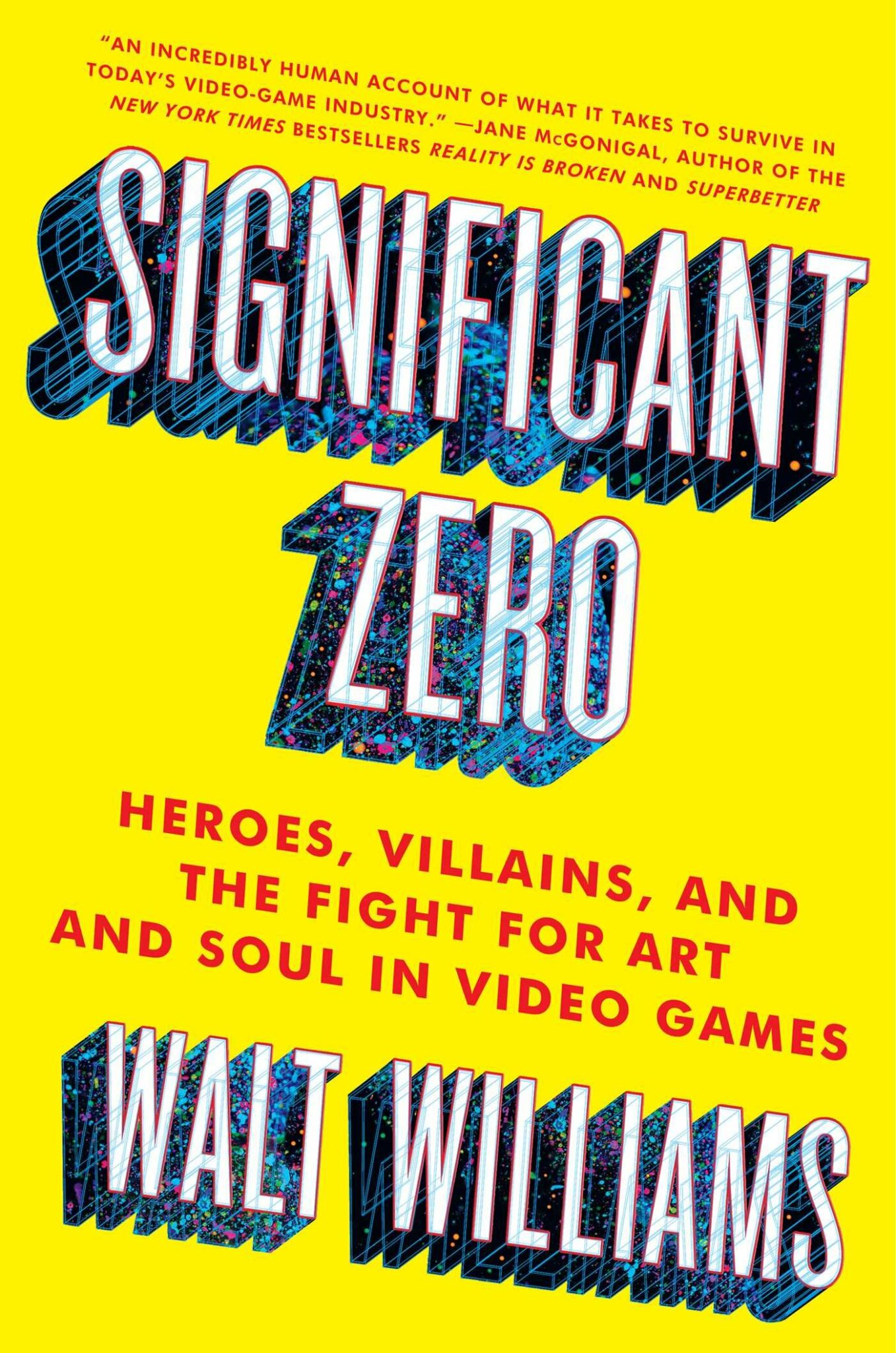
Walt Williams, who was the lead writer for the story on Spec Ops: The Line, has written a book about his experiences in the games industry. Significant Zero” (Atria Books, 304 pages, approx. 20 euros), which is only available in English, sheds light on the working conditions in the industry and especially at publisher Take-Two Interactive. With a lot of wit, Williams shows the pitfalls of game development and demystifies the profession of the author, among other things by citing the chaotic development of Spec Ops: The Line.
2007 the military shooter genre begins to mushroom. Call of Duty switches from World War II to a future scenario with Modern Warfare, Battlefield has already been playing in the modern era since its second part, and many other shooters are in development. “The genre was very crowded at the time. To stand out, we looked for our own niche in it,” says Williams. The niche he’s talking about: depicting war as truthfully as possible, rather than celebrating it.

“Violence leaves a mark on everyone, that’s what we wanted to show “
War and violence are an essential element of computer and video games. In strategy games we fight huge battles as commanders, in first-person shooters we shoot hundreds of enemies without giving it a second thought.
“Violence has been the predominant way gamers have interacted with digital worlds for decades, it’s expected and it’s financially and morally safe,” Williams says. The new Spec Ops aims to be different. The developers want players to confront the consequences of their actions. “Violence is not an empty, senseless act. It leaves a mark on everyone, and we wanted to show that.”
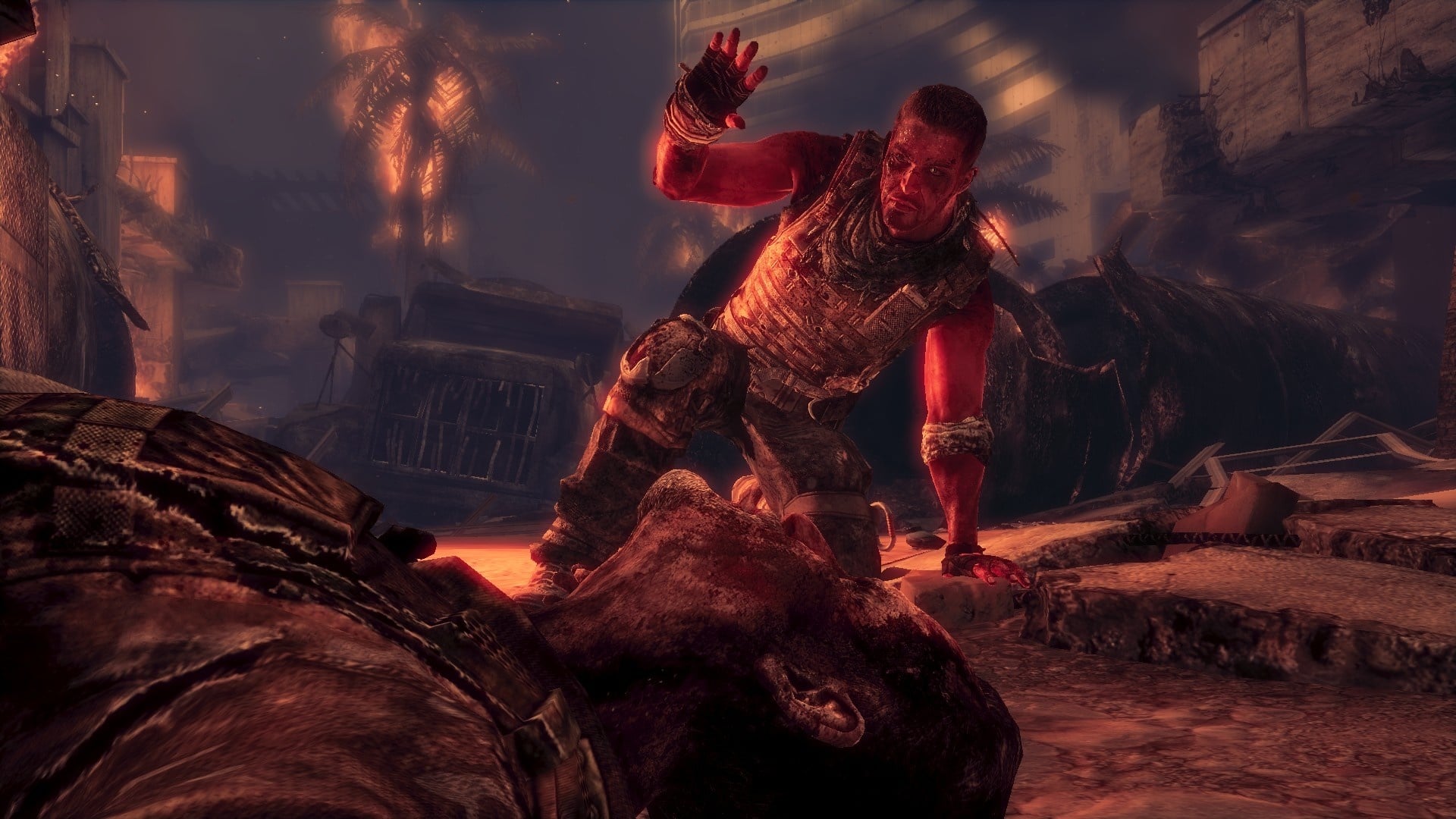
The new Spec Ops is designed to send the player on a journey. Yager uses the novel “Heart of Darkness” by Joseph Konrad as inspiration. The book was published at the end of the 19th century and is set in the Belgian Congo, a colony in Central Africa. Sailor Charlie Marlow recounts his journey as captain of a river steamer, witnessing the horrors of European colonialism.
On the Congo River, Marlow sails deeper and deeper into the eponymous Heart of Darkness in search of the ivory trader Kurtz. In 1979, Francis Ford Coppola takes up the idea in his anti-war film “Apocalypse Now” and relocates it to the Vietnam War. Yager now wants to transplant the Heart of Darkness to Dubai.
“Everyone on the team was immediately sold on the idea and wanted to transplant it to Spec Ops. The only question was how exactly we should do it,” recalls Jörg Friedrich. He worked as a game designer at Yager, took care of the artificial intelligence and then switched to level design.
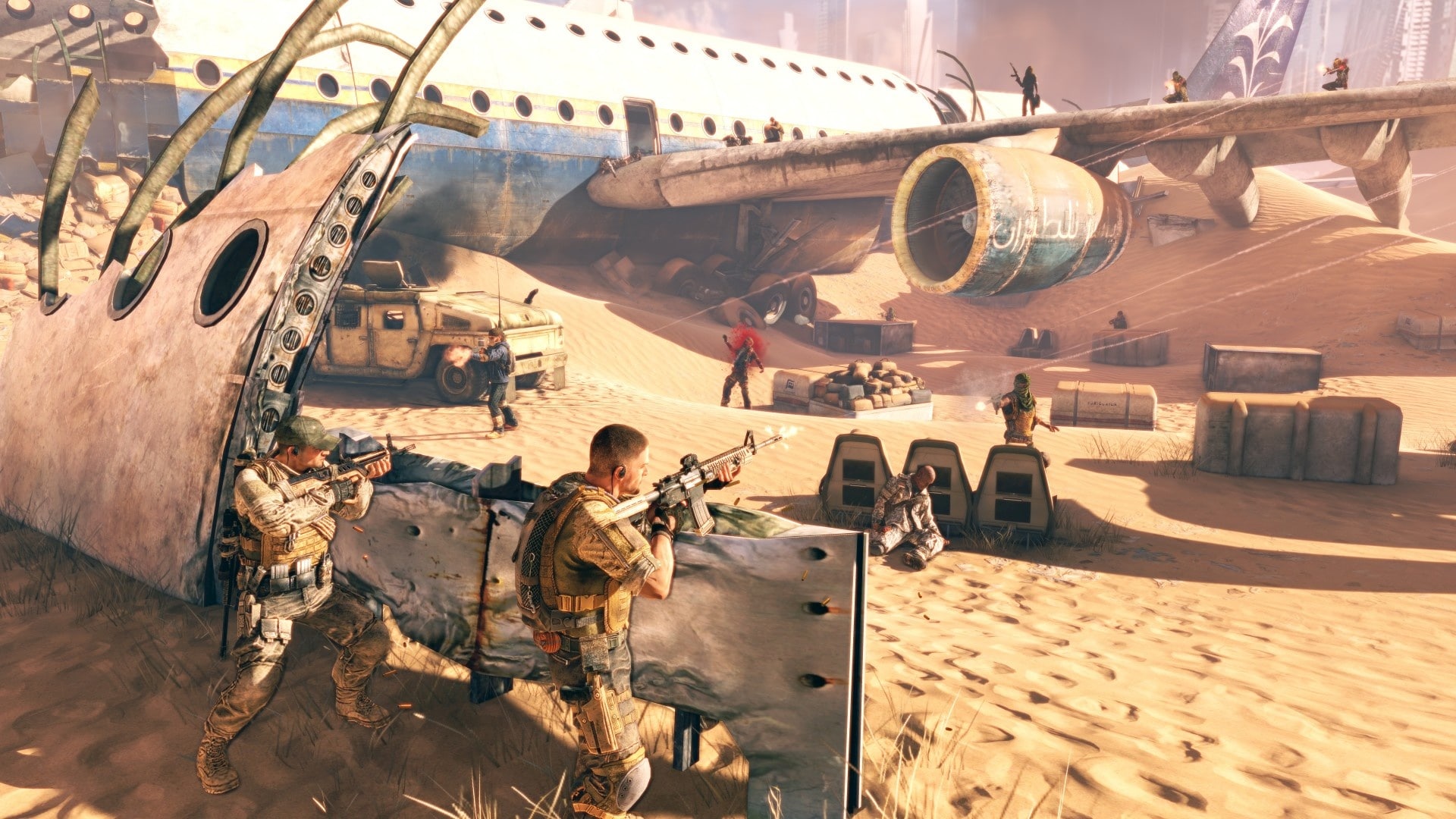
A river trip like in the prequels is out of the question in Spec Ops. Although there is a Dubai Creek in Dubai, it is only 14 kilometres long, which is why the game would have ended pretty quickly. Instead, Yager opts for Sheikh Zayed Road, the largest and most famous street in Dubai. The player is to follow this road on his journey to the city’s tallest building, the Burj Khalifa.
The journey there is to be undertaken by the player in a Delta Force Squad, an elite unit of the US Army. The player controls Captain Martin Walker, followed by Lieutenant Alphonse Adams and Staff Sergeant John Lugo. Lead writer Williams pondered the names and personalities of the characters.
“Adams and Lugo were named after friends of mine who were in the military. Some people assume Walker was named after myself, but the truth is much more mundane.” So Williams had called a meeting to discuss the main character’s name. “Well, he walks a lot, so we call him Walker.” It will be several more years before the characters reach their final form.
The green fields of Dubai
As a setting, Dubai also changes shape as it develops. In early versions, the player reaches a desert city where lush meadows grow, as illustrations by art director Mathias Wiese show. Only in the course of the game does a sandstorm overtake Dubai. “This created great lighting moods and bizarre shapes,” says Wiese, who studied sculpture. During the five years of development, he drew thousands of sketches and storyboards, sometimes up to two per meeting, which piled up in the company basement.
To realistically depict the desert city, Wiese and lead artist Jason Flanagan travel to the United Arab Emirates in 2008. They roll down sand dunes and pour sand over their heads to see how it looks on their skin. “We’ve seen the sand dunes everywhere in these luxury hotels,” Wiese says.
The two fly back to Berlin with hundreds of photos of hotel lobbies and skyscrapers in their luggage. Wiese rummages through his memories and lets his imagination run wild: Spec Ops is supposed to be visually more varied than other shooters at the time, so classic warehouse levels are a no-go.
Wiese draws luxury lobbies adorned with golden peacocks, malls and withered swimming pools and tries to sell his ideas to the level designers. “As an art director, your whole day consists of convincing other people of your ideas.” To bring the levels to life and get the mood right, the developers snap hundreds of screenshots, which the concept artists then paint over. “This allows you to look into the future,” says Wiese.
In parallel, the recreation of the city runs in a heavily modified Unreal Engine 3. Friedrich and the level designers make sure that the players know where to go. It is clear early on that Spec Ops will be a linear game.
Special Effects Lead Florian Zender is responsible for the sandstorms and sand avalanches in the game and makes sure that the many sand particles don’t put too much strain on the game’s performance. Especially when art director Wiese is once again at his desk with illustrations that are technically very difficult to realise.
Zender painstakingly places destructible window panes by hand, sacrificing several weekends for the intro sequence alone. The animations of the sand avalanches are also technically demanding.
Yager works on Spec Ops: The Line from 2007 to 2009, without the game being officially announced. Many in the team are worried that the project will be cancelled again because it might have become too expensive for publisher 2K after all. The work is stressful, there are crunches: “There were always work weeks of 60 to 80 hours,” says Ullmann. As Yager’s managing director, he has to find a constant balance between creative desires and ideas that can be implemented.
The mood in the team is tense, also because of the game’s serious subject matter. “Our focus was on a dark, mature and thought-provoking narrative,” says Cory Davis. In 2008, he joins Yager and works on the game as creative director. For years, he’ll keep reminding himself and the team of the game’s fundamental idea, which can get lost amidst the controversial content.
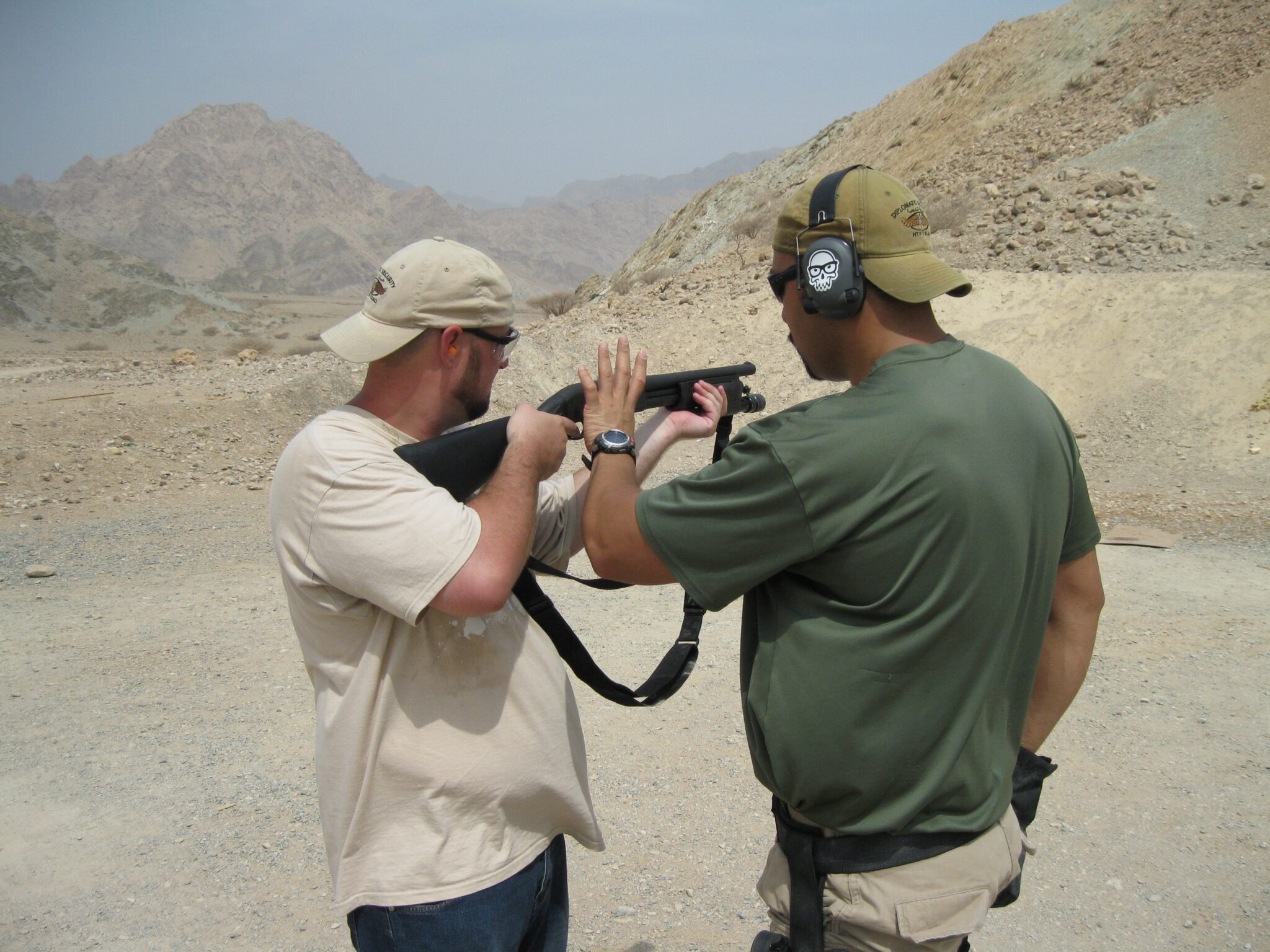
Tastelessness as marketing
Spec Ops shows violence not only to soldiers but also to civilians. A controversial topic that other games have failed at before. Eidos released the Vietnam shooter Shellshock ‘Nam 67 in 2004, which was supposed to show the “dark side of war”. The game featured faceless characters and spilled over into tasteless atrocities that were intended to shock alone. In 2004, the shooter was indexed and rightly fell into oblivion.
The shooter Six Days in Falluja was also criticised. The title refers to a battle in the Second Iraq War at the end of 2004, in which more than 1,800 people died in house-to-house combat in the Iraqi city of the same name, including 800 civilians and more than 100 US soldiers.
Konami wanted to turn the battle into an ultra-realistic shooter, but because of a public outcry over the tastelessness of the setting, the publisher cancelled the game in April 2009. Now it is to be released at the end of 2022 after all, but is criticised by historians for its lack of political context.
“To shock is easy,” says Williams. “We wanted to go beyond just shocking with Spec Ops.” To achieve this, Yager ties every scene in the game to the story: Walker – and by extension, the player – believes he is doing the right thing while leading his group down the wrong path. In the process, he crosses several lines after which there is no turning back. The Spec Ops title is born: The Line.
Yager also reaches his limits during development. Many hours of work, the uncertain outcome of whether the game will be released at all and the fraught subject matter surrounding war crimes wear on the nerves. Pictures of war wounds and napalm victims from the Vietnam War serve as a template, “those were really disturbing shots,” Ullmann recalls.
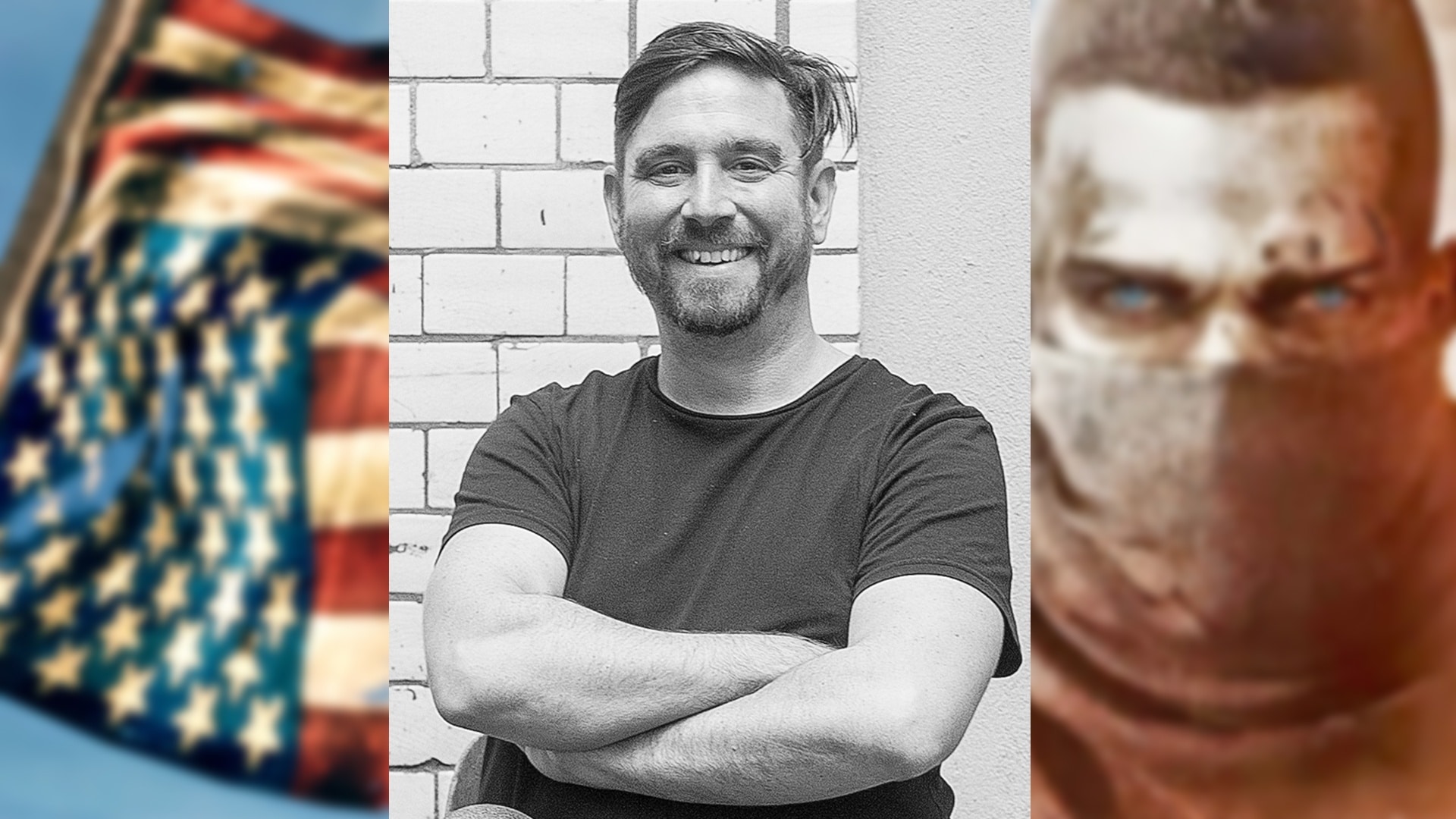
Slowly, the characters and the story begin to take on a life of their own, which captivates the developers at Yager. They try to put themselves in the shoes of the characters. “Walker, Lugo and Adams haunted my dreams and still do,” says creative director Davis. He loses his inhibitions, immerses himself in the story and drifts into darkness, as he says himself:
“They feel like they’re a part of me, it’s hard to describe. It can be a very dark and downright sad experience, but it’s a real experience that I cherish and wouldn’t trade for a happier ending.”
Williams also becomes deeply immersed in the story and the characters, losing weight and unable to sleep. For the loading screens, he writes short texts addressed directly to the player: “Well, do you feel like a hero yet?” “How many Americans have you killed today?”
The story team gradually lets the squad go haywire. The characters become more unprofessional as the game progresses, shouting around and executing enemy soldiers. Their clothes are tattered and their faces are covered in blood. Not only for Walker and the Squad, but also for Yager, Spec Ops: The Line is a journey into the heart of darkness.
One of the most memorable scenes in the game occurs over several years: the White Phospor. The warfare agent releases white smoke that is highly flammable and causes severe burns. Human rights organisations classify the weapon as a war crime.
Friedrich wants White Phosphorus in the game because it is a controversial weapon. In an initial idea, the player was supposed to be able to carry mortars and phosphorus grenades around in the game and use them in different places. “But we finally decided against it because it wouldn’t have fit the narrative,” says Friedrich.
It is a tightrope walk to show violence in order to convey a message, but not to become too explicit. So even the flamethrower is removed from the game as a weapon because, according to Davis, it was “too devastating”. All that remains of the White Phosphorus in the finished game is the original tutorial level, which explains how to use the mortar.
Warning: the following paragraph contains spoilers
For many, the sequence is still etched in their minds today. Players feel bad, guilty, yet they believed they were doing the right thing. After many months and numerous iterations, one of the best scenes of Spec Ops: The Line has emerged.]
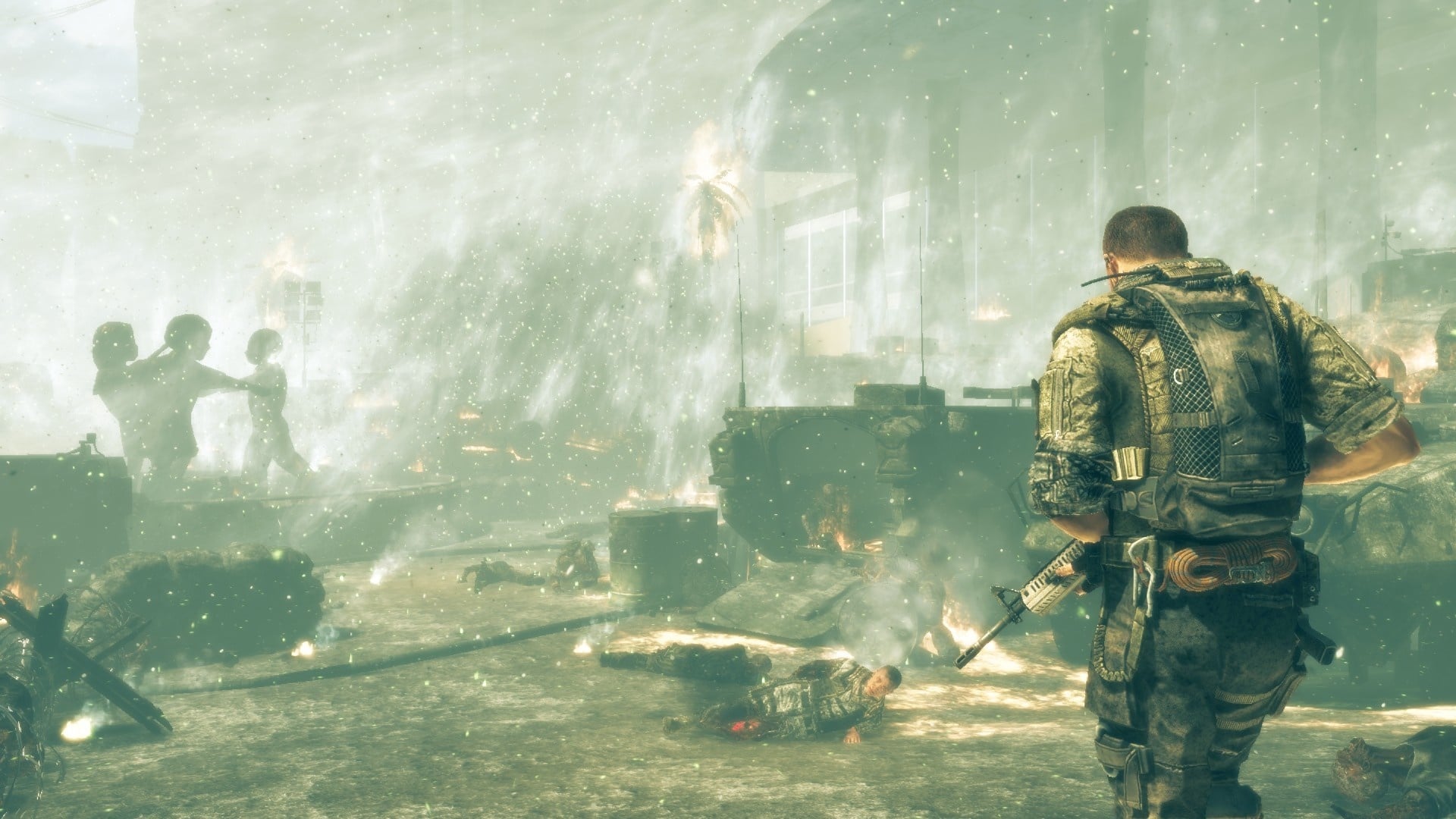
But rather a simple shooter?
2009 the shooter is announced at the Spike Video Game Awards. Yager keeps doubting his idea: can an anti-war shooter with moral choices even work?
“For years we placed untextured males in grey untextured environments. We had doubts in the team and thought about whether we shouldn’t just make a simple shooter,” says Friedrich.
It was also completely unclear whether the moral decisions in the game would have any effect at all. Already in previous games like Bioshock, the player could decide whether to suck the Adam completely out of the Little Sisters or save the girls. In Spec Ops: The Line, decisions are more ambivalent: is it really better to let the CIA agent live, only for him to burn horribly a few minutes later?
“With gameplay, at some point you know if it works or not. But whether a decision is close to you or not is much harder to implement,” Friedrich said. Yager therefore kept inviting playtesters, explaining the context to the players, some of which didn’t even exist yet, and observing the reactions.
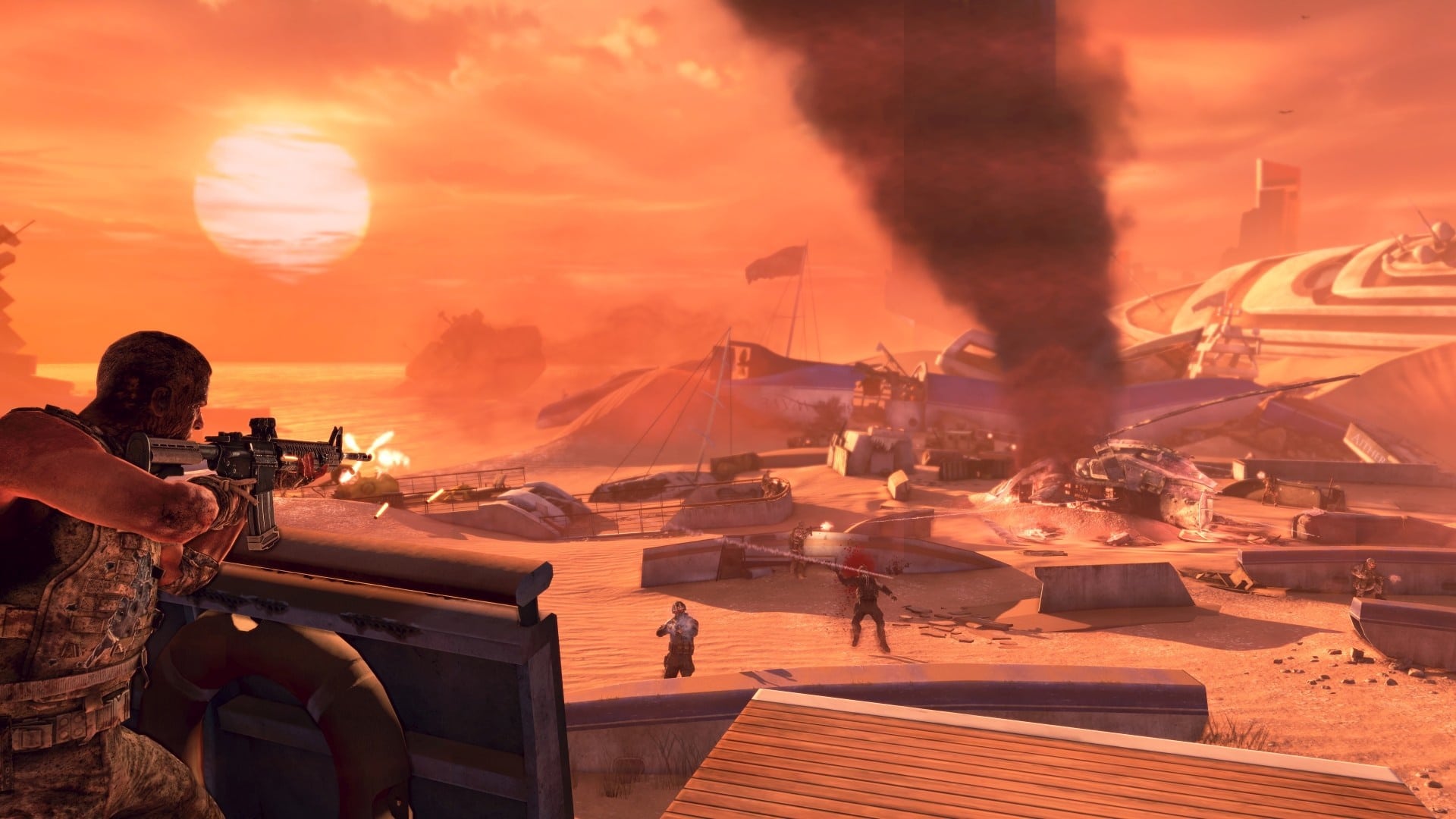
2010 and 2011 Spec Ops: The Line is entering the home stretch. “It was a very stressful time,” says Ullmann. “At the beginning of development, gameplay had still driven the production, now it was the story.”
Levels have to be rebuilt because they don’t fit the narrative. Actors are added to cutscenes via motion capture, voice-overs are running, you’d think Spec Ops: The Line was going to be an anti-war movie. 2K has already poured millions into the game at this point, after almost five years it is finally supposed to be finished. Until the very end, everyone is wondering: does it all fit together well?
Late satisfaction
Spec Ops: The Line will be released on 26 June 2012. Mathias Wiese is in Italy that day and picks up a foreign games magazine at the petrol station. Spec Ops: The Line is printed on the cover. “We were all very proud when the game was then released and eagerly awaited the first reviews.”
Gamespot is the first medium to write a review. The moral decisions were nice, but not groundbreaking, and the gameplay was out of date. The website gives (a 6.5). The sales figures are also disappointing, (according to estimates) the game sold only 770,000 copies by May 2013, Take-Two talks about it being below expectations. Spec Ops: The Line is difficult to market because it starts as an ordinary shooter and only unfolds its story as the game progresses. But the ratings are getting better.
As of February 2022, Spec Ops: The Line has a Metascore of 76, and on Steam it is rated “extremely positive”. Graphics and gameplay are now outdated. But the game still convinces with its story. It comments on the state of the shooter genre, in which players have been conditioned over the years to shoot at everything.
Spec Ops: The Line shows what emotional possibilities the medium of computer games offers. Call of Duty now also uses White Phospor as a weapon. In Modern Warfare, you can use the combat agent in multiplayer. However, nothing of the terrible effects can be seen in the game. Characters simply drop dead, and nothing more than a cough can be heard.
Other shooters do it better and tell gripping stories: In the Metro series we survive in the post-apocalypse, in Wolfenstein: The New Order we experience the tyranny of the Nazi regime in all its brutality.
Yager became known worldwide through Spec Ops: The Line and has developed strongly. There is not to be a sequel. “The story is told,” says Williams. Many former Yager developers still work at the Berlin studio. Timo Ullmann is still managing director, Mathias Wiese draws sketches as art director and is expanding the sci-fi shooter The Cycle.
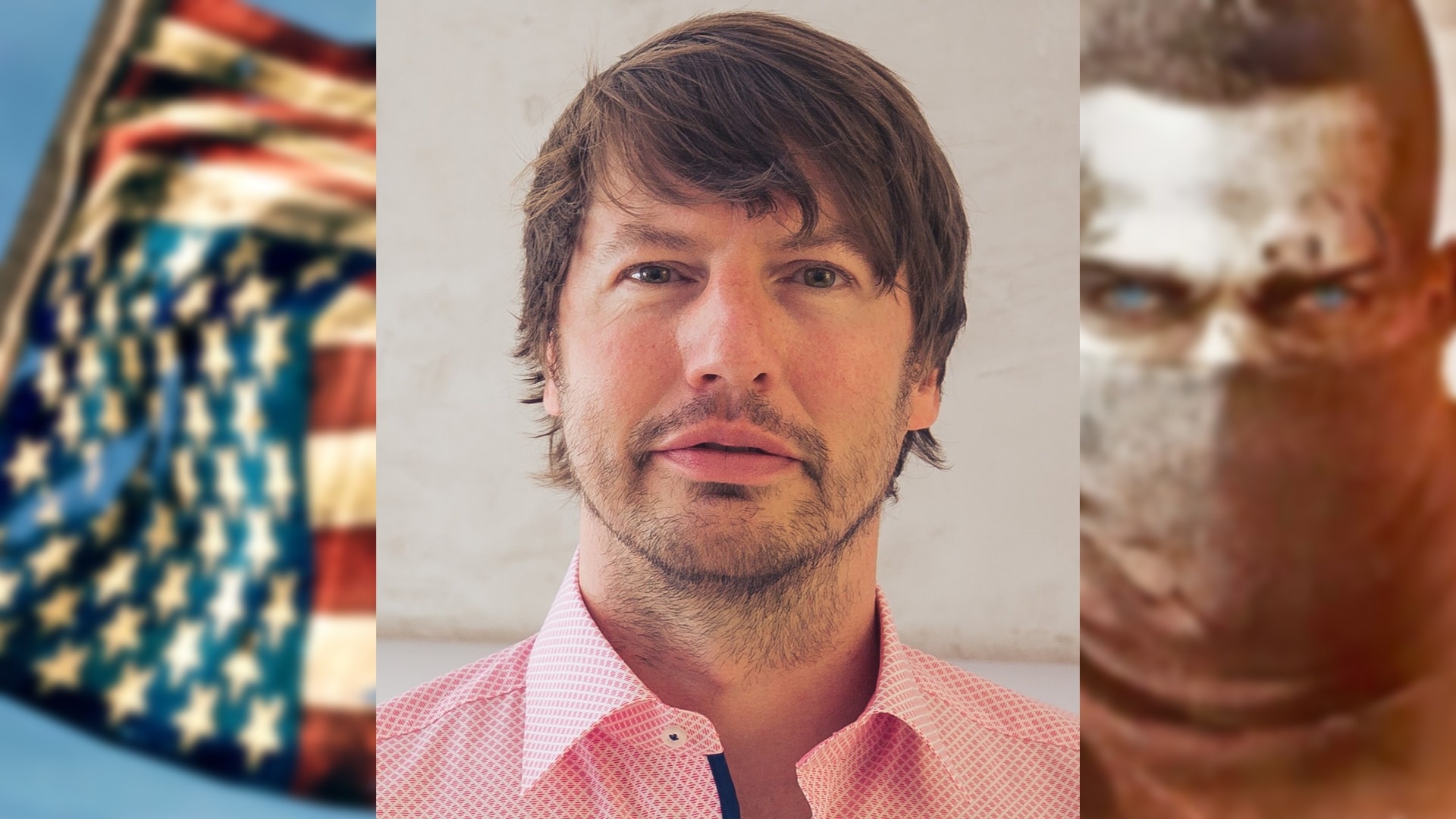
Jörg Friedrich leaves the studio in 2015, founds Paintbucket Games with Sebastian Schulz and publishes the award-winning anti-fascist indie game Through the Darkest of Times. Cory Davis co-founds the game studio Eyes Out in 2018 with Robin Finck, guitarist of the band Nine Inch Nails. Florian Zender has moved to MachineGames, makers of the Wolfenstein games.
Walt Williams now works as a story writer at Insomniac Games, which most recently released Ratchet & Clank: Rift Apart for Playstation 5. He thinks of Spec Ops: The Line often: “The game still speaks to people. That alone makes me proud to have worked on it. “

